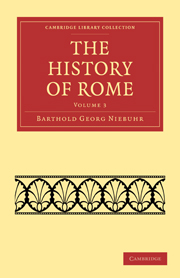Book contents
- Frontmatter
- PREFACE
- Contents
- The Licinian Rogations
- The new curule Dignities of the year 384
- Internal History down to the complete establishment of the plebeian Consulship
- On the Uncial Rate of Interest
- History of the Wars from 384 to 406
- Rome in Alliance with Latium
- The earliest Constitution of the manipular Legion
- The first Samnite War
- The Latin War
- The Laws of the Dictator Q. Publilius
- Internal History down to the Caudine Peace
- Alexander of Epirus
- Forein Relations down to the second Samnite War
- The second Samnite War
- Relations between Rome and the Nations bordering on Samnium after the Peace
- The Etruscan Wars down to the beginning of the third Samnite War
- Internal History from the Caudine Peace down to the third Samnite War
- Cn. Flavius
- The Censorship of Q. Fabius and P. Decius
- The Ogulnian Law
- Various Occurrences of the same Period
- The third Samnite War and the Others of the same Period
- Internal History from the Beginning of the second Samnite War down to the Lucanian
- Miscellaneous Occurrences of the same Period
- The Etruscan and Gallic War
- The Lucanian, Bruttian, fourth Samnite, and Tarentine Wars
- Epirus and Pyrrhus
- The Roman and Macedonian Tactics
- The War with Pyrrhus
- Entire Subjugation of Italy, and the Political Rights of the Italian Allies
- Internal History and Miscellaneous Occurrences of the Period from the Lucanian down to the first Punic War
- The first Punic War
- Index
- ERRATA
Relations between Rome and the Nations bordering on Samnium after the Peace
Published online by Cambridge University Press: 01 June 2011
- Frontmatter
- PREFACE
- Contents
- The Licinian Rogations
- The new curule Dignities of the year 384
- Internal History down to the complete establishment of the plebeian Consulship
- On the Uncial Rate of Interest
- History of the Wars from 384 to 406
- Rome in Alliance with Latium
- The earliest Constitution of the manipular Legion
- The first Samnite War
- The Latin War
- The Laws of the Dictator Q. Publilius
- Internal History down to the Caudine Peace
- Alexander of Epirus
- Forein Relations down to the second Samnite War
- The second Samnite War
- Relations between Rome and the Nations bordering on Samnium after the Peace
- The Etruscan Wars down to the beginning of the third Samnite War
- Internal History from the Caudine Peace down to the third Samnite War
- Cn. Flavius
- The Censorship of Q. Fabius and P. Decius
- The Ogulnian Law
- Various Occurrences of the same Period
- The third Samnite War and the Others of the same Period
- Internal History from the Beginning of the second Samnite War down to the Lucanian
- Miscellaneous Occurrences of the same Period
- The Etruscan and Gallic War
- The Lucanian, Bruttian, fourth Samnite, and Tarentine Wars
- Epirus and Pyrrhus
- The Roman and Macedonian Tactics
- The War with Pyrrhus
- Entire Subjugation of Italy, and the Political Rights of the Italian Allies
- Internal History and Miscellaneous Occurrences of the Period from the Lucanian down to the first Punic War
- The first Punic War
- Index
- ERRATA
Summary
The fate of the Hernicans was upon the whole decided in the same way as that of the Latins had been thirty years before. The three towns which had not revolted, retained their laws, and mutual connubium: without doubt the commercium too: but scarcely the right of holding diets. Anagnia and the other Hernicans became municipia without the suffragium and were governed by prefects, who exercised jurisdiction among them, and whom the Roman pretor appointed annually: for their ordinary magistrates who remained nominally, in order that the worship of the gods might not be disturbed, were exclusively confined to the performance of the priestly functions of their office. They were deprived of the connubium with the other Hernicans and undoubtedly of the commercium also, and this too with the same intentions as the Latins had been. Frusino lost according to Diodorus as early as 441 (447), according to Livy as a punishment for an attempt to excite the nation to revolt in 444 (450), a third part of its territory: which land, as Diodorus states, was sold. Rome had now got rid of the obligations incumbent upon it by the treaty, though these perhaps latterly had no longer consisted in giving up a third part of the spoil, but in the Roman treasury giving pay to the contingent of the Hernicans, and only assigning a part of the spoil to them: which was considered so important a gain, that an equestrian statue was erected to C. Marcius in front of the temple of Castor.
- Type
- Chapter
- Information
- The History of Rome , pp. 261 - 273Publisher: Cambridge University PressPrint publication year: 2010First published in: 1842



